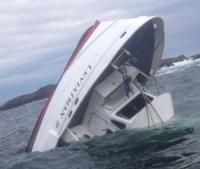 The first reports from accidents are often wrong. In the case of the capsizing of the whale-watching boat, Leviathan II, off Tofino on Vancouver Island with the loss of six passengers, the initial reports from CBC News said that the vessel was originally a tug boat that had been modified as a whale watching boat. They also reported that the “refitted Leviathan II didn’t have to undergo more stringent stability tests outlined by Transport Canada that are reserved for larger vessels.” (In our blog post, we repeated these statements with a link back to the CBC article.)
The first reports from accidents are often wrong. In the case of the capsizing of the whale-watching boat, Leviathan II, off Tofino on Vancouver Island with the loss of six passengers, the initial reports from CBC News said that the vessel was originally a tug boat that had been modified as a whale watching boat. They also reported that the “refitted Leviathan II didn’t have to undergo more stringent stability tests outlined by Transport Canada that are reserved for larger vessels.” (In our blog post, we repeated these statements with a link back to the CBC article.)
Apparently, these statements were not accurate. Transport Canada, in response to this and related reporting, issued a statement saying that the MV Leviathan II did undergo both a stability assessment and an inclining test when it was refitted in 1996. An inclining test is a means of accurately determining a ship’s vertical center of gravity (VCG), which is a critical component of determining a ship’s stability. Once an accurate VCG has been calculated based on the results of the inclining tests, the ship owner must present calculations demonstrating that the vessel meets all stability requirements in accordance with national requirements. According to Transport Canada, Leviathan II met all stability requirements.
So, why did Leviathan II capsize? Much has been made of reports that most of the ship’s 26 passengers were on the port side on the upper deck when the vessel was hit by a wave from the starboard side. Passengers on the upper deck, clustered outboard near the rail would indeed reduce the available stability of the vessel. Nevertheless, the ability to retain adequate stability with an off-center weight of passengers is one of the criteria used to judge the stability of a passenger ships.
Another factor is the number of passengers onboard. Leviathan II had a reported passenger capacity of 46, so the 27 passengers and crew aboard should have been well within the designed stability criteria. Even if, all passengers were crowded on the post side of the upper deck, the off-center loading should have been roughly half of the design load used in the stability calculations.
So, again, why did Leviathan II capsize? Transport Canada has secured the damaged vessel. With luck, they will be able to find the answer to this one critical question.

It’s not unusual in fully researched (final) incident reports for a detailed history of a vessel to reveal seemingly innocuous additions to top hamper or windage leading to unexpected effects (unexpected without stabiliy calculations and/or another inclining). But this firm doesn’t seem to bear the hallmarks of the sort of organization that would take such shortcuts.
I am not sure what the controlled stability test shows compared to the stability condition in a seaway with a top deck loaded with sightseers. When I served in the Canadian Coastguard and one of the lighthouses we serviced was Lennard Island off Tofino, BC. The weather in that area is more often rough than calm thus the tour boat would most likely be wallowing in the sea conditions while whale-watching. This would result in highly varying stability compared to the controlled test particularly with the top deck loaded with whale watchers.
Good Watch.
I looked at the Canadian rules for passenger vessels and their regulations appear to mirror SOLAS standards, as one might expect. There are rules designed to address the problem of the weight of passengers clustered along the rail. The rule requires a minimum righting arm with all the passengers along one side that is intended to ensure enough reserve stability to avoid capsizing. Given that the boat was at about half her passenger capacity, there should have been ample reserve stability.
The wave conditions off the reefs where the ship capsized, no doubt, played a role. We will have to wait for the results of the Canadian authorities investigation.
Thanks for the update, Rick. Good reporting.